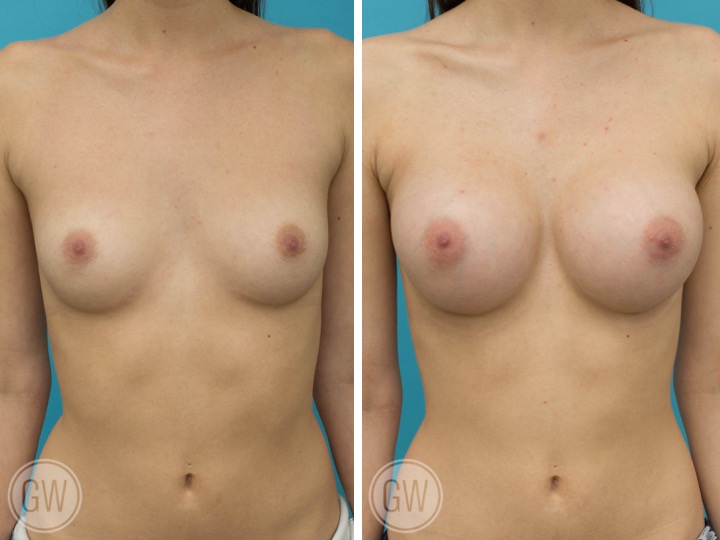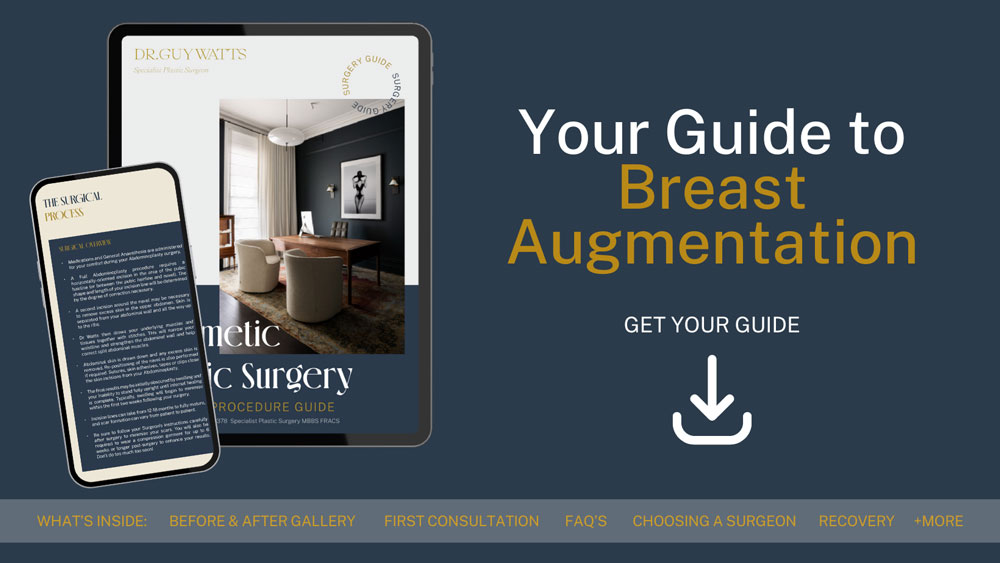
14 Jul Managing Your Breast Augmentation Scar
Dr. Guy Watts, a Specialist Plastic & Reconstructive Surgeon in Perth, WA, understands that breast augmentation is a significant procedure designed to address breast shape and volume. While the surgical technique is an essential part of treatment, careful attention to the healing process and scar management also plays an important role in the final outcome.
Every surgical incision leaves a scar, but modern surgical techniques and dedicated post-operative care can significantly minimise its visibility over time. Proper scar care begins immediately after surgery and continues for months as the skin and underlying tissues heal. By following Dr. Watts’ expert guidance, patients can achieve a refined, subtle scar that blends naturally with the surrounding skin.
This comprehensive guide provides essential information on breast augmentation scarring, healing timelines, effective aftercare techniques, and advanced treatment options. Whether you are preparing for surgery or are already in the healing phase, this resource will help you understand how to care for your scars to achieve optimal outcomes.
Take our quiz, and find out if you are ready for surgery
Why Do Scars Form After Breast Augmentation?
Scars are a natural result of the body’s healing process. When an incision is made during surgery, the body immediately works to repair the wound by generating new collagen fibres. This collagen production is essential for rebuilding the skin, but in the early phases of healing, the scar may appear raised, firm, and red. Over time, as collagen is rearranged and broken down, the scar softens, flattens, and fades.
The way a scar heals varies from person to person. Several factors contribute to the appearance of scars, including genetics, skin type, incision location, post-surgical care, and lifestyle choices. Some individuals naturally form finer, less visible scars, while others may experience thicker or more pigmented scars.
Proper wound care, avoiding unnecessary tension on the incision site, and using evidence-based scar treatments can significantly improve the final appearance of scars. With meticulous surgical technique and consistent post-operative care, most patients find that their scars become barely noticeable over time.
Types of Breast Augmentation Incisions and Their Impact on Scars
The placement of your breast augmentation incision directly affects where your scar will form and how visible it will be after healing. Dr. Watts carefully selects the most suitable incision technique based on the patient’s anatomy, the type of implant, and individual aesthetic goals.
✓ Inframammary Incision (Under the Breast Fold)
The inframammary incision is placed along the natural crease beneath the breast. This is one of the most commonly used techniques because it allows for precise implant positioning while keeping the scar well hidden within the breast fold. Over time, as the scar fades and blends with the surrounding skin, it becomes almost invisible when standing upright.
This incision technique is ideal for patients of all body types and works well with both saline and silicone implants. Additionally, the location of the incision supports minimal disruption to the breast tissue, reducing the risk of complications such as nipple sensitivity changes or difficulty with breastfeeding.
✓ Periareolar Incision (Around the Areola)
The periareolar incision is made along the outer edge of the areola, where the natural transition in skin tone helps conceal the scar. This technique is often chosen when a patient is undergoing both a breast augmentation and a breast lift simultaneously. It provides direct access to the breast tissue, allowing for precise implant placement.
While this incision offers an excellent cosmetic outcome for many patients, it is not suitable for everyone. Patients with very small areolas may not have enough space for the incision. Additionally, while rare, there is a slightly higher risk of changes in nipple sensation or difficulties with breastfeeding when using this approach.
✓ Transaxillary Incision (Through the Armpit)
The transaxillary incision is placed within the natural folds of the armpit, keeping the scar completely off the breast itself. This method is often preferred by patients who wish to avoid any breast scarring.
Although this incision offers an excellent cosmetic advantage, it is more technically demanding and is better suited for saline implants, which can be inserted while deflated and filled once in position. Silicone implants require more extensive maneuvering through the incision, which may limit the control a surgeon has over precise placement.
Each of these incisions has its own advantages and limitations, and Dr. Watts carefully evaluates each patient’s unique anatomy and goals before recommending the most appropriate approach—helping to avoid some of the most common surgical errors during breast augmentation.
DOWNLOAD DR WATTS’ GUIDE TO BREAST AUGMENTATION

Understanding the Phases of Scar Healing
Scars do not heal overnight. The process unfolds over several months to a year, and understanding what to expect can help patients stay proactive with their post-operative scar management routine.
✓ Immediate Healing Phase (0-6 Weeks)
During the first few weeks after surgery, the incision may appear red, slightly raised, and swollen.This is because the body is in the active repair stage, producing new collagen to strengthen the tissue. Some tightness or mild discomfort is common as the skin contracts and begins to heal.
To support proper healing, it is essential to keep the incision clean and protected. Patients should avoid stretching or putting tension on the scar, as excessive movement can widen the incision and lead to a more noticeable scar.
✓ Scar Maturation Phase (3-6 Months)
Between three to six months post-surgery, the scar begins to soften and flatten as collagen production stabilises. The initial redness may start to fade, and the scar may take on a pink or light brown tone, depending on skin type.
At this stage, patients can begin using silicone gel sheets or medical-grade scar creams to help support optimal healing and scar refinement.
✓ Long-Term Healing Phase (6-18 Months)
Over time, scars continue to mature and fade.The final colour and texture of the scar may take up to 18 months to fully develop. With proper care, most scars blend seamlessly into the surrounding skin, becoming barely noticeable. Understanding the full scope of your recovery journey can further support successful healing. For a comprehensive look at what to expect after your procedure, read our guide on Recovery After Breast Augmentation.
Essential Scar Management Techniques for Optimal Healing
✓ Protecting the Scar from Sun Exposure
One of the most important factors in scar healing is avoiding direct sunlight on the incision site. UV exposure can cause scars to darken permanently, making them more noticeable. Patients should wear SPF 30+ sunscreen on healed scars if exposed to sunlight and cover the area with clothing whenever possible.
✓ Using Silicone-Based Scar Treatments
Silicone sheets and gels are clinically proven to hydrate the scar, regulate collagen production, and reduce thickness. These treatments should be applied consistently for at least 3-6 months to see the best results.
✓ Scar Massage for Tissue Softening
Once the incision is fully healed, gentle scar massage can help break down thickened scar tissue and promote smoother, more flexible skin. Massage should be done with clean hands and a recommended scar cream to further enhance results.
✓ Considering Advanced Scar Treatments for Additional Refinement
For patients who require additional scar refinement, Dr. Watts offers a range of advanced scar treatments, including laser therapy for pigmentation correction, microneedling with platelet-rich plasma (PRP) to boost collagen, and steroid injections for raised or thick scars.
FAQs about Breast Augmentation Scar Management
Final Thoughts
Breast augmentation scars are a natural part of the healing process, but with proper care, they can become discreet and well-blended with the surrounding skin. Dr. Guy Watts provides expert guidance, personalised aftercare recommendations, and advanced scar management options to help patients achieve the best possible results.
For more information or to schedule a consultation, visit Dr. Watts’ office and call (08) 9286 1600 to learn more about breast augmentation and post-operative care.
Further Reading
- Read more about Guy Watts’ blog about Top 10 Methods to Reduce Scars after Breast Reduction Surgery
- Read more about Guy Watts’ blog about Scar Management after Plastic Surgery
- Read more about Guy Watts’ blog about Scars
- Read more about Guy Watts’ blog about Types of Breast Implant Incisions
About Dr. Guy Watts – MED0001539378
FRACS (Plas) – Specialist Plastic Surgeon In Perth WA
Dr. Guy Watts is a Specialist Plastic Surgeon (AHPRA MED0001539378) with an extensive career that spans across renowned plastic surgery clinics worldwide. His experience has been honed through invaluable experiences at esteemed establishments such as the New York Eye and Ear Infirmary and the renowned Pitanguy Clinic in Brazil.
Having collaborated with the foremost cosmetic plastic surgeons on a global scale, Dr. Watts has chosen to return to Perth after a 17-year journey of intensive training and invaluable professional experience to bring the latest practices and technology in cosmetic plastic surgery to his patients.
Dr. Watts is a Fellow of the Royal Australasian College of Surgeons (FRACS) and a Member of the Australian Society of Plastic Surgeons (ASPS), Australasian Society of Aesthetic Plastic Surgeons (ASAPS) and the International Society of Aesthetic Plastic Surgeons (ISAPS).
Read about the potential Risks and Complications of Surgery
Read the Patient Information and Resources
About CLINISPA
Clinispa is Dr Watts’ bespoke medical clinic performing Cosmetic Aesthetic treatments. At Clinispa, we offer advanced clinical treatments in a luxurious and calming environment, tailored to support your skin’s health and appearance.
Clinispa aesthetic services are performed by Dr Guy Watts’ nursing professionals, who have a passion for and solid understanding of facial aesthetics.
All Clinispa clients are considered individually, with a personalised treatment plan consisting of advanced scientific approaches to cosmetic aesthetics. We incorporate innovative technologies in conjunction with superiorly formulated skin care.
For more information about the full range of Clinispa Aesthetic of Cosmetic Treatments visit the Clinispa website








Sorry, the comment form is closed at this time.